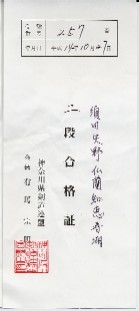
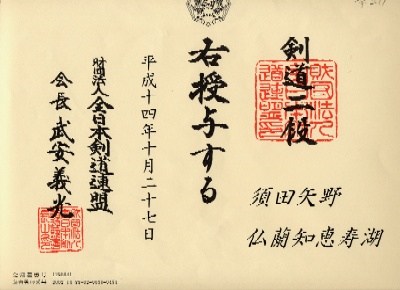
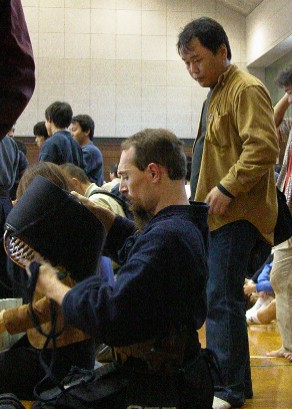 On Sunday 27 October 2002, I earned the rank of second dan in
kendo. So far I have taken all my kendo examinations in Japan, at the
Saiwai-ku sports centre in Kawasaki (although I was no longer living
there at the time of the 2-dan exam). What follows is a personal
account of what was for me a very special event.
On Sunday 27 October 2002, I earned the rank of second dan in
kendo. So far I have taken all my kendo examinations in Japan, at the
Saiwai-ku sports centre in Kawasaki (although I was no longer living
there at the time of the 2-dan exam). What follows is a personal
account of what was for me a very special event.
First, the format of the exam. This depends to some extent on where it's held: in Kanagawa prefecture, the one covering the city of Kawasaki, 2-dan requires two one-minute fights, a written test about kendo theory and a display of the first five kata. (But in neighbouring Tokyo, for example, I'm told that seven kata are required for 2-dan.)
The written test is usually considered the easy part by the
candidates, since a list of possible questions with their official
answers are sent to dojo leaders a couple of months ahead of
the exam. In my case, though, it was the hardest, because my Japanese
is still very basic and certainly way too poor to write an essay. The
grammatical patterns I understand are rather limited and I couldn't
even parse (let alone rephrase) the model answers without extensive
help. However, as I did for shodan, what I could do was to study,
understand and then learn by heart all the model answers, and
"recite", or rather transcribe, the appropriate ones in hiragana
(Japanese phonetic characters) at the exam. To ask to be allowed to
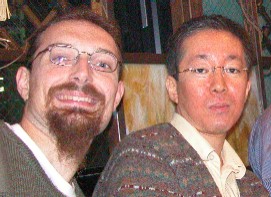 answer the questions in English would
have felt like cheating (after all, what's the point of proudly
grading in Japan if one can't even follow the Japanese procedure) so I
spent the previous month studying the three model answers, of which
two would be selected on the day. I could never have done this,
though, without the precious help of my friend Masegi-San (3-dan) who,
as he had done for my previous exams, carefully prepared a four-way
study sheet for me with the questions and answers in kanji, hiragana,
rōmaji for good measure and finally English translation! I am
also grateful to my many other Toshiba colleagues whom I recorded
reading out the Japanese text to help me memorize it. Last but by no
means least, my thanks for this endeavour go to my special friend and
personal Japanese teacher Ōshima-san, who conscientiously went
over all the model answers with me a further time, giving me literal
translations of every word of every sentence and patiently answering
all my questions about the underlying grammar that held them all
together.
This process of learning the model answers word for word was lengthy
and sometimes frustrating, but I found it beneficial: it marginally
improved my Japanese, it etched into my mind some important kendo
principles as expressed by senior kendo masters, but above all it was
an application and reinforcement of the
I-can-handle-any-shit-coming-my-way kendo spirit.
answer the questions in English would
have felt like cheating (after all, what's the point of proudly
grading in Japan if one can't even follow the Japanese procedure) so I
spent the previous month studying the three model answers, of which
two would be selected on the day. I could never have done this,
though, without the precious help of my friend Masegi-San (3-dan) who,
as he had done for my previous exams, carefully prepared a four-way
study sheet for me with the questions and answers in kanji, hiragana,
rōmaji for good measure and finally English translation! I am
also grateful to my many other Toshiba colleagues whom I recorded
reading out the Japanese text to help me memorize it. Last but by no
means least, my thanks for this endeavour go to my special friend and
personal Japanese teacher Ōshima-san, who conscientiously went
over all the model answers with me a further time, giving me literal
translations of every word of every sentence and patiently answering
all my questions about the underlying grammar that held them all
together.
This process of learning the model answers word for word was lengthy
and sometimes frustrating, but I found it beneficial: it marginally
improved my Japanese, it etched into my mind some important kendo
principles as expressed by senior kendo masters, but above all it was
an application and reinforcement of the
I-can-handle-any-shit-coming-my-way kendo spirit.
The three candidate questions were:
I spent many evenings learning to recite the answers and almost all my waking time in the trip to Japan (including the ride to the airport) practicing to write them down in hiragana. Apart from getting them right, speed also mattered—at the exam for shodan I finished several minutes after everybody else, which was a cause of embarrassement. I got to the point where I could write down all three answers in just over 20 minutes—still a bit slow but almost acceptable (this also gives you a rough idea of the amount of text I had memorized: it took 3 or 4 minutes for a native Japanese speaker to read it all out loud).
I got to my hotel in Kawasaki on Friday evening, having left
Cambridge on Thursday afternoon and having attempted to pre-condition
away the 8-hour jetlag by gradually shifting to Japan time before
leaving (crazy idea but it almost worked). On Saturday morning at
09:00 I met my master Naganuma-sensei (6-dan),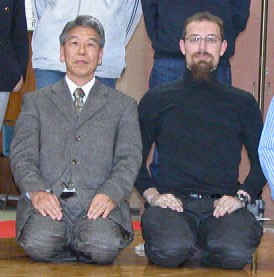 the dojo captain
Tsuruma-san (5-dan) who trained me daily taking me from beginner to
first dan in one year, and half a dozen of other friends at the
Toshiba dojo, who graciously accepted to devote that
morning's session to special training for my exam. A little kihon, a
little ji-geiko and then many simulations of the exam procedure, to
get all the details of the protocol just right.
the dojo captain
Tsuruma-san (5-dan) who trained me daily taking me from beginner to
first dan in one year, and half a dozen of other friends at the
Toshiba dojo, who graciously accepted to devote that
morning's session to special training for my exam. A little kihon, a
little ji-geiko and then many simulations of the exam procedure, to
get all the details of the protocol just right.
Kendo grading in Japan, especially at the low dan levels in which several hundred candidates must be assessed in one morning, is a highly optimized chain-factory operation and all the details are precisely specified to avoid wasting any time. For example, for the fights the candidates are broken into groups of five and then each entrant does two one-minute fights: 1-2, 2-3, 3-4, 4-5, 5-1; at the end of a fight, say the first, the outgoing (1) and incoming (3) candidates both face the one who stays (2) and bow to him/her at the same time, thereby "saving" one rei per candidate. But everyone involved must be ready and be in the right place on the correct side ahead of time (especially Mr. 1) or the whole thing becomes a mess. So we practiced all this protocol several times, with the sensei ensuring my familiarity with the behaviour of both the "external" (1) and "internal" (2,3,4,5) members of the group, as well as dealing with exceptions such as what to do if the referee stops you. I can't even begin to explain how thoroughly and caringly the members of the dojo looked after me in preparation for the exam—as they also did for a whole year when I was living there.
After this practice it was time for kata. I did the five kata with the sensei, in both roles of course, and he corrected a number of details; then I practiced them again with almost every other member until they were satisfied.
At the end of the session I collected, folded and packed my equipment. Although standard practice at the Cambridge dojo, this was unusual for the Komukai dojo because in ordinary circumstances we have the luxury of being able to leave everything to dry in the hall itself or in the adjacent changing room, conveniently to find it there the next day.
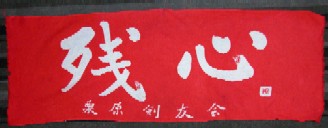 That morning I also received a special present. My Toshiba friend
Kubo-san (3-dan), on top of being one of the most regular members of
our daily practices at the Komukai dojo inside the company
compound, also practices kendo at the Kurihara dojo
near his home. At his invitation, I have visited the Kurihara
dojo on several occasions. Every one of those times the
leader of the dojo, Morikawa-sensei (7-dan), has always been
extremely generous towards me: despite my being the lowest-ranking
That morning I also received a special present. My Toshiba friend
Kubo-san (3-dan), on top of being one of the most regular members of
our daily practices at the Komukai dojo inside the company
compound, also practices kendo at the Kurihara dojo
near his home. At his invitation, I have visited the Kurihara
dojo on several occasions. Every one of those times the
leader of the dojo, Morikawa-sensei (7-dan), has always been
extremely generous towards me: despite my being the lowest-ranking
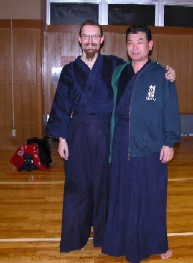 adult kendoka in the hall, he
always treated me like a VIP guest, gave me more than my fair share of
ji-geiko time with him, pointed out what I should do to improve,
treated me to very fine Japanese dining after the trainings, and even
gave me his own shinai! I now proudly use it for suburi every morning
(never for fights, of course—even though the power emanating from it
would focus my ki much better than when I use my own shinai, I
obviously want to keep it in one piece).
adult kendoka in the hall, he
always treated me like a VIP guest, gave me more than my fair share of
ji-geiko time with him, pointed out what I should do to improve,
treated me to very fine Japanese dining after the trainings, and even
gave me his own shinai! I now proudly use it for suburi every morning
(never for fights, of course—even though the power emanating from it
would focus my ki much better than when I use my own shinai, I
obviously want to keep it in one piece).
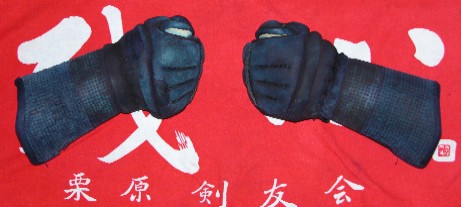 Well, as if having already given me his own
shinai and the Kurihara tenugui were not enough, on another visit to
his dojo Morikawa-sensei offered me his precious yoroi-gote!
This is a special kind of kote fashioned after the traditional samurai
armour—an old-style piece of valuable craftsmanship. I am told by my
Japanese seniors that it is now almost impossible to have a pair of
yoroi-gote made unless you are 8th dan, because the know-how is being
lost. And he gives them to me! Can you imagine how happy I was at
this?!?
Well, as if having already given me his own
shinai and the Kurihara tenugui were not enough, on another visit to
his dojo Morikawa-sensei offered me his precious yoroi-gote!
This is a special kind of kote fashioned after the traditional samurai
armour—an old-style piece of valuable craftsmanship. I am told by my
Japanese seniors that it is now almost impossible to have a pair of
yoroi-gote made unless you are 8th dan, because the know-how is being
lost. And he gives them to me! Can you imagine how happy I was at
this?!?
Before actually giving them to me, though, he wanted to send them in for maintenance to have some minor blemishes repaired. Kubo-san took care of that, so on my previous visit to Japan I saw the yoroi-gote but didn't actually get them. Now, though, Kubo-san had brought them back. There they were, perfectly restored, beautifully majestic and full of the spirit of a 7-dan who honoured me with his friendship. Of course these would be the ones I would wear at the exam the following day—together with the red "zanshin" tenugui from Kurihara!
After the Saturday morning session at the Toshiba Komukai dojo, five of us then went to a Chinese restaurant for lunch, with Naganuma-sensei insisting on treating me. More kendo advice over the course of the lunch, as imaginable. And, here too, from the members of my own dojo, I was made to feel like a VIP guest, and my success in the exam the next day seemed to be the most important business of the whole kendo club! You have no idea how supportive and encouraging they have always been to me. It is thanks to this atmosphere that I have been able to progress so quickly in kendo.
I spent the afternoon in my hotel room trying to shave down a few more minutes from my hiragana handwriting times. At some point I took a break from that and dismantled and neatly sandpapered my shinai. Then more writing practice until the evening. At peak performance I managed to get down to some 5 minutes per question, with no mistakes except in punctuation.
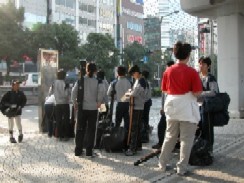 The following morning, going
to Kawasaki station to catch the bus to the Saiwai-ku sports center, I
met a bunch of teenagers going to the same exam. The sports hall
opened at 09:00. I was there for the opening,
The following morning, going
to Kawasaki station to catch the bus to the Saiwai-ku sports center, I
met a bunch of teenagers going to the same exam. The sports hall
opened at 09:00. I was there for the opening, 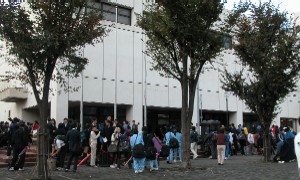 with gazillions of high school
children queueing in front of the doors. This helped put things into
perspective: 2-dan was a big deal for me, but here in Japan the exams
for 1, 2 and 3-dan (the ones that took place that morning) are stuff
people do before even going to university...
with gazillions of high school
children queueing in front of the doors. This helped put things into
perspective: 2-dan was a big deal for me, but here in Japan the exams
for 1, 2 and 3-dan (the ones that took place that morning) are stuff
people do before even going to university...
On entering the hall, the names of all
the entrants were written on tiny vertical strips pasted along the
walls. Near the end of the list (I think we were sorted by age) I
found the one with my name in kanji—number 257. 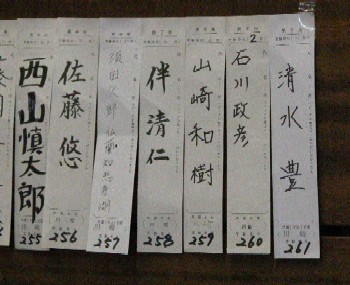 The highest number
in that row was 261, but there were another 20 or so extra candidates
(whose number was prefixed by K) who were there only for the kata,
having failed it in the previous session six months before. We all
wrote our numbers on our three o-dare (zekken removed) with a piece of
chalk.
The highest number
in that row was 261, but there were another 20 or so extra candidates
(whose number was prefixed by K) who were there only for the kata,
having failed it in the previous session six months before. We all
wrote our numbers on our three o-dare (zekken removed) with a piece of
chalk.
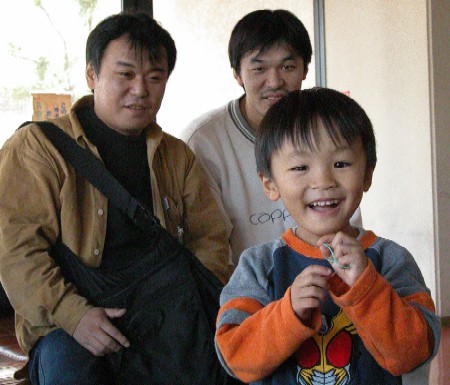 First, they examined all the 1st
dan candidates, which were the vast majority. This went on until about
lunch time. Then they did the 2-dan and the 3-dan ones in
parallel. There were about a dozen judges, split among two independent
exam areas along the length of the hall. My number wasn't called until
after 13:00. For all this time it was wait, wait, wait—but I had
plenty of kendo friends who had given up their Sunday to come and
support me for the exam. It was fantastic! The dojo captain
Tsuruma-san was there from 09:00. Half a dozen others trickled in over
the next couple of hours. You haven't seen team spirit until you've
been at the centre of this kind of experience.
First, they examined all the 1st
dan candidates, which were the vast majority. This went on until about
lunch time. Then they did the 2-dan and the 3-dan ones in
parallel. There were about a dozen judges, split among two independent
exam areas along the length of the hall. My number wasn't called until
after 13:00. For all this time it was wait, wait, wait—but I had
plenty of kendo friends who had given up their Sunday to come and
support me for the exam. It was fantastic! The dojo captain
Tsuruma-san was there from 09:00. Half a dozen others trickled in over
the next couple of hours. You haven't seen team spirit until you've
been at the centre of this kind of experience.
Anyway, at some point it was finally time to get ready and lined up in rows of 5 for the fights. I was in the last group of the 2-dan candidates and, being 257 out of 261 I was the "number 1", the one doing the first and last fight of the group instead of two consecutive ones. I very carefully put on my men, tightening the chō-musubi (bow knot) in the prescribed manner so as to prevent it from coming undone, as per the written test I memorized last year for the shodan exam. I neatly arranged the himo. My captain rechecked the neatness and flatness of the back of my keikogi. Everything was perfect. And I waited for some more until our group had to get up.
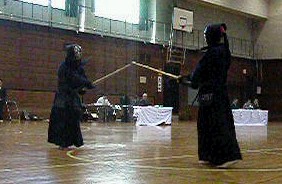 At last, my first fight—257 vs 258. And, shame and
embarrassement, after the first couple of clashes my men came off and
I had to request a break! Argh! I was so frustrated. So I went back in
seiza and, acting as dignified as I could, I removed men and redid it
again, even more tightly and carefully. With hindsight, the probable
cause of this disgrace was that that morning, to honour the special
occasion, I made the mistake of shampooing my beard (something I don't
usually do) which obviously made it shiny, thereby causing the chin
rest of the men to slip in a way that wouldn't usually occur. Grrr!
Anyway, after resuming the fight I wasn't quite heijōshin (calm
in the face of adversity) so I didn't perform at my best in these
remaining fifty seconds; still, I managed to keep my back straight and
score a couple of passable men.
At last, my first fight—257 vs 258. And, shame and
embarrassement, after the first couple of clashes my men came off and
I had to request a break! Argh! I was so frustrated. So I went back in
seiza and, acting as dignified as I could, I removed men and redid it
again, even more tightly and carefully. With hindsight, the probable
cause of this disgrace was that that morning, to honour the special
occasion, I made the mistake of shampooing my beard (something I don't
usually do) which obviously made it shiny, thereby causing the chin
rest of the men to slip in a way that wouldn't usually occur. Grrr!
Anyway, after resuming the fight I wasn't quite heijōshin (calm
in the face of adversity) so I didn't perform at my best in these
remaining fifty seconds; still, I managed to keep my back straight and
score a couple of passable men.
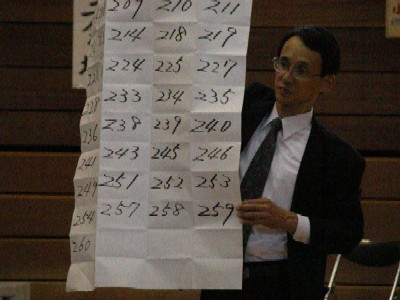 I did regain some composture by the time
of my other fight, the one against Mr. 261; but I had also become even
more aggressive, as I couldn't stand the idea of losing the exam over
a slipped men! So I attacked with very strong spirit, strong kakegoe
and powerful zanshin, definitely overpowering my opponent and
dominating the situation, although my technical level wasn't really
that good—too stiff and full of tension, and with too little
variation. Anyway, a decent fight overall. As I left the match area, I
felt I had done ok, and I also got some thumbs-up from my supporters.
I did regain some composture by the time
of my other fight, the one against Mr. 261; but I had also become even
more aggressive, as I couldn't stand the idea of losing the exam over
a slipped men! So I attacked with very strong spirit, strong kakegoe
and powerful zanshin, definitely overpowering my opponent and
dominating the situation, although my technical level wasn't really
that good—too stiff and full of tension, and with too little
variation. Anyway, a decent fight overall. As I left the match area, I
felt I had done ok, and I also got some thumbs-up from my supporters.
Since my group was last, at least I didn't have to wait for long for the result. Of the whole batch of 2-dan candidates that had been fighting for the last hour or so, the judges wrote the numbers of those who passed this first stage on a large poster, which was then on display for a couple of minutes. Sure enough, I was in. Great!
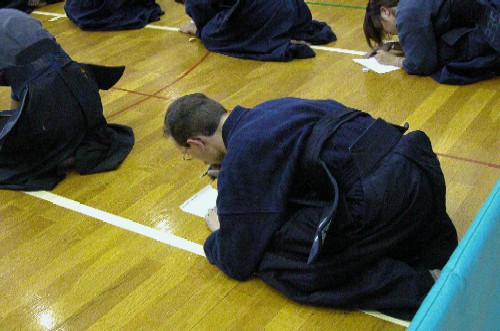 For the written test we all went back in the
match area, we lined up by number and were given a sheet of paper
each. We wrote our name and number, spaced ourselves out, lined up
again and finally sat in seiza. Then one of the judges wrote the two
questions on a blackboard and read them aloud with his microphone:
they were the first two of the list, the ones about zanshin and about
kakegoe. One of the referees came up to me to check that I understood
what to do, then left. I started writing frantically, with no
hesitation but hoping that I wouldn't overrun, covering the whole page
in my primitive-looking hiragana. I was too busy writing to pay any
attention to what was happening around me, so it was with delight that
I found that, on completing my second question, I was not
last! There were still several other people writing. Wow! I got
up from seiza and went to the judges' desk to hand in my sheet. I
waited for a while behind another candidate who was talking to them;
then, when he left, one of the judges asked me something in Japanese
that I couldn't understand. At my puzzled look another judge asked me
if I spoke English (yes...) and whether I needed an explanation about
the questions. No, I said, I only wanted to hand this in, so I did and
I left the exam area.
For the written test we all went back in the
match area, we lined up by number and were given a sheet of paper
each. We wrote our name and number, spaced ourselves out, lined up
again and finally sat in seiza. Then one of the judges wrote the two
questions on a blackboard and read them aloud with his microphone:
they were the first two of the list, the ones about zanshin and about
kakegoe. One of the referees came up to me to check that I understood
what to do, then left. I started writing frantically, with no
hesitation but hoping that I wouldn't overrun, covering the whole page
in my primitive-looking hiragana. I was too busy writing to pay any
attention to what was happening around me, so it was with delight that
I found that, on completing my second question, I was not
last! There were still several other people writing. Wow! I got
up from seiza and went to the judges' desk to hand in my sheet. I
waited for a while behind another candidate who was talking to them;
then, when he left, one of the judges asked me something in Japanese
that I couldn't understand. At my puzzled look another judge asked me
if I spoke English (yes...) and whether I needed an explanation about
the questions. No, I said, I only wanted to hand this in, so I did and
I left the exam area.
Later, while the judges were marking the answers, I saw from a distance that one was half-laughing and calling the others to see the piece of paper he was holding; and the others were then laughing too. Written in phonetic hiragana instead of kanji, like first-grade primary school children do, and in what must have looked like the handwriting of one, I can imagine the dialogue my writtten test triggered: "have a look at this; you know, the guy who wrote all this stuff is the gaijin who couldn't even understand your question..."
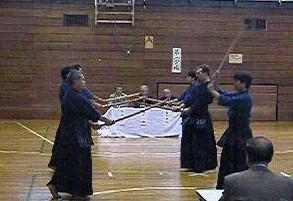 Finally, the
kata. Once again I was in the last group, so I had a chance to see
plenty before me. They were done in batches of 5 pairs. We were all
arranged in columns of 5, and repeatedly one of the referees assigned
the roles of uchidachi and shidachi to two of the columns, which were
then forwarded to opposite sides of the exam area. The five pairs ran
the kata along parallel lines and were required to make some effort to
stay in sync, while judges from both sides assessed the performance. I
could see several rather poor kata, with people cutting at the wrong
distance (I mean seriously wrong) or with the wrong timing or
Finally, the
kata. Once again I was in the last group, so I had a chance to see
plenty before me. They were done in batches of 5 pairs. We were all
arranged in columns of 5, and repeatedly one of the referees assigned
the roles of uchidachi and shidachi to two of the columns, which were
then forwarded to opposite sides of the exam area. The five pairs ran
the kata along parallel lines and were required to make some effort to
stay in sync, while judges from both sides assessed the performance. I
could see several rather poor kata, with people cutting at the wrong
distance (I mean seriously wrong) or with the wrong timing or 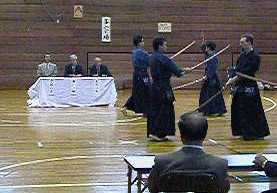 even making actual
mistakes and asking for permission to redo the kata again. I thought
the standard was a bit low.
even making actual
mistakes and asking for permission to redo the kata again. I thought
the standard was a bit low.
When my turn came, I was again in the last group, which had only three pairs. I was in the middle pair, with the role of uchidachi. My partner was also an adult, perhaps a few years older than me. From the sonkyo it looked as if he knew his stuff, which of course pleased me since he was supposed to follow my lead. And so it was: ippon-me went very smoothly, with good timing and good distance, and I could see an imperceptible nodding from him at the end of that kata, as if he too were saying "I'm glad I've got a competent uchidachi, let's keep this up". So we did a neat nihon-me and sanbon-me, and at the end of the sanbon-me the referee "in the field" (as opposed to the ones at the judges' desks) came to me from behind, touched my keikogi and told me "chotto matte kudasai", please wait a little. Why? I checked to my sides and both the other pairs were still in the middle of their sanbon-me. How come? Had I been going so fast? It certainly didn't feel so: I think I had kept a slow and dignified pace. I only realized later, during lunch, on seeing the movie shot by one of my friends, that actually both of the other pairs had made a mistake during their sanbon-me and restarted it while we were completing ours! That's why we had finished first, but I had no clue at the time. Anyway, once everyone was back in place I took hassō-no-kamae for yonhon-me, we did that smoothly too, and finally—with evident confidence from both sides—gohon-me. We were pleased when we saluted each other in sonkyo, and the first thing I did after leaving the exam area was to go and congratulate with my partner. My friends came around and said it was a good kata, predicting that I had now passed.
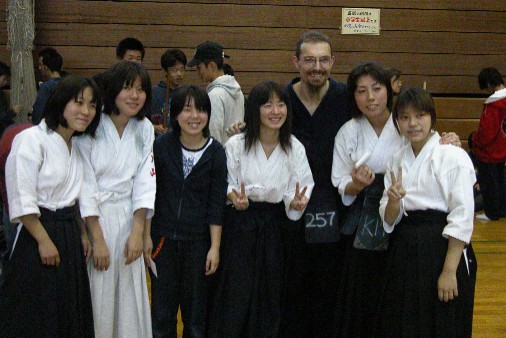 We then had to go back in the exam
area, sitting in seiza, when the judges called out a few candidates to
talk to them personally. These were the ones who would have to redo
their kata at the next exam session, and there were many fewer than I
would have imagined (at least for 2-dan standard—I thought they'd be
much stricter). Finally the poster went up again, this time with the
final "pass" results, which included my number. After that it was a
matter to queue up with all the others to pay the required 7,000 yen
for the calligraphic certificate that would be forthcoming in a few
months, and to get the small receipt certifying that on 27 October of
the 14th year of Heisei I earned the rank of nidan.
We then had to go back in the exam
area, sitting in seiza, when the judges called out a few candidates to
talk to them personally. These were the ones who would have to redo
their kata at the next exam session, and there were many fewer than I
would have imagined (at least for 2-dan standard—I thought they'd be
much stricter). Finally the poster went up again, this time with the
final "pass" results, which included my number. After that it was a
matter to queue up with all the others to pay the required 7,000 yen
for the calligraphic certificate that would be forthcoming in a few
months, and to get the small receipt certifying that on 27 October of
the 14th year of Heisei I earned the rank of nidan.
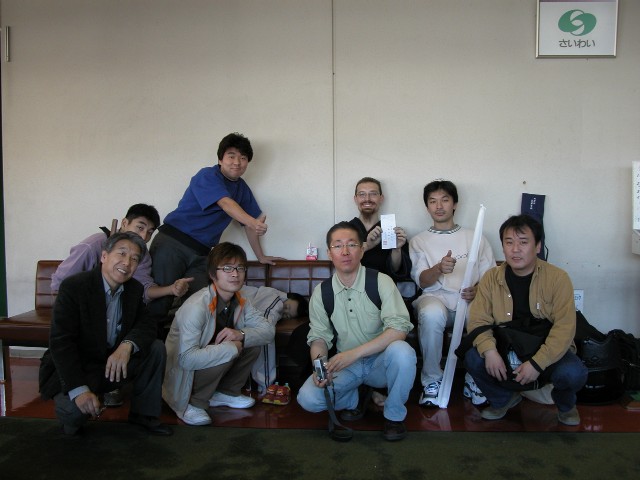 As we were all happily commenting
the performance and congratulating other kendoka, one of the judges
came to my captain and told him that the panel congratulated me on the
kata, one of the best of the day, and was impressed with the written
test. Of course there's always an element of extra politeness towards
the foreigner in all this, but it was nonetheless good to hear.
As we were all happily commenting
the performance and congratulating other kendoka, one of the judges
came to my captain and told him that the panel congratulated me on the
kata, one of the best of the day, and was impressed with the written
test. Of course there's always an element of extra politeness towards
the foreigner in all this, but it was nonetheless good to hear.
By then it was about 14:30 so, after a few celebratory pictures, I got changed and invited all my friends to a restaurant where we had a late but delicious Japanese lunch. Then I went back to my hotel, exhausted but happy. As my seniors repeatedly reminded me during the meal, the appointment is in two years for my first chance, after the prescribed delay, to attempt the 3-dan exam.
Text and pictures © Francesco Stajano 2002
Back to Frank's home page or to those of the Tsurugi Bashi or Toshiba Komukai kendo clubs
.

![]() validated (recheck)
validated (recheck)
![]()